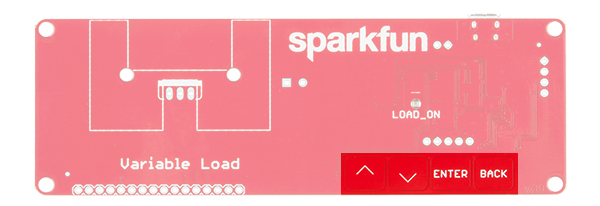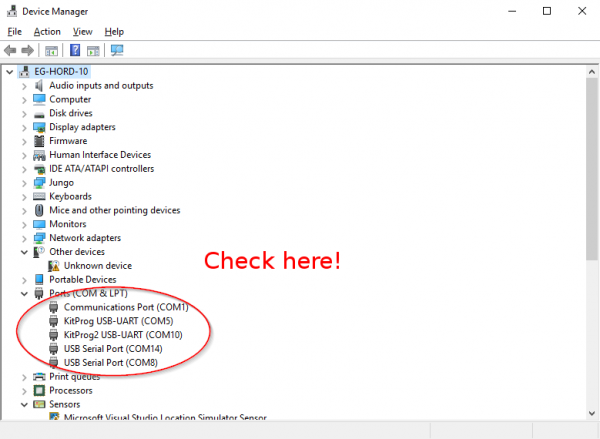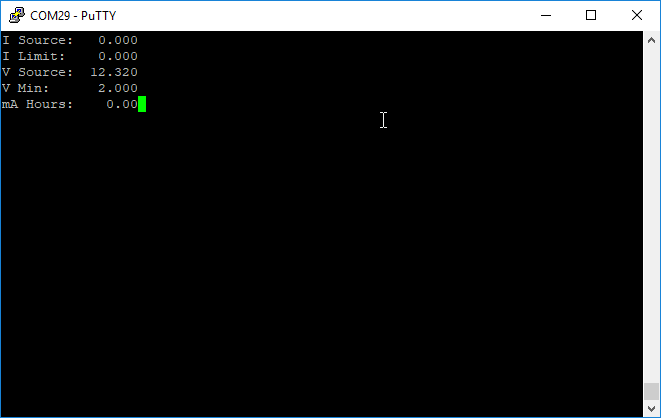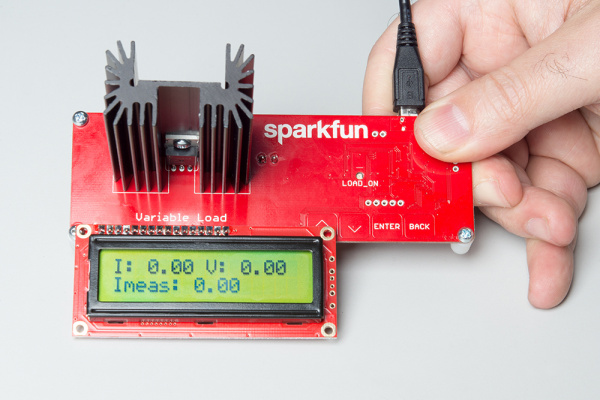Variable Load Hookup Guide - Revised
Operation
The Variable Load board is designed to work with one of two output modes. Either using a:
- Console on a PC for Feedback
- Basic 16x2 Character LCD
In either case, the capacitive touch buttons on the front of the Variable Load PCB can be used to change the settings.
General Operation
The primary method for controlling the Variable Load is the set of capacitive touch buttons on the front of the board. There are four buttons: up arrow, down arrow, "Enter" and "Back". The up and down arrow keys will adjust the current set point up or down in steps determined by the present set point. The higher the set point, the larger the step size. The "Enter" key turns the load on or off without affecting the set point, and the "Back" button resets the set point to zero.
There is an LED visible from the front of the board which will tell you whether the load is enabled or disabled at any given time.
The voltage limit for the board is 40V. Exceeding this level may cause damage to the circuits on board. The current limit is 4A, and the board will not in any case let you set a current draw above 4A. There is also a wattage limit of 15W, which is calculated in live time. Normally, the current draw remains the same as the voltage is increased, but if the voltage is increased beyond a point where the product of the voltage and current exceeds 15W, the output will be disabled until the voltage drops to a safe point again.
Using a Console for Output
Start by checking out our serial terminal basics tutorial. This will get you up and running with a serial terminal. Open a serial terminal program (i.e. PuTTY) to connect.
You'll need to identify the port name of the Variable Load board when it is connected. There are a few methods of determining which port the Variable Load Board is connected to.
One method to determine which port the Variable Load board is on, I recommend using the Arduino IDE. Under the "Tools" menu, there is a sub-menu for "Port". Since we had connected the USB cable to a computer's COM port already, make note of the items on the listed port names. Then unplug the micro-B USB cable from your computer. Give it a few seconds, then re-open that sub-menu to see what item has disappeared. By process of elimination, we can determine the port name that the Variable Load has enumerated to. Reconnect the cable to verify. The port name should reappear as the same name in the sub-menu. Remember, the Arduino IDE's Serial Monitor will not work with the Variable Load board.
Windows
If you don't have the Arduino IDE installed and don't want to install it, you can find the same information using built in tools. Under Windows, open up your device manager (if you don't know how to do this, do a search online for OS specific information on how to do it since it's slightly different under various versions of Windows). Take note of the devices on the list, then unplug the Variable Load and see which port on the list disappears. The port which disappeared from the list is the one you want.
Mac
Using a Mac OS, you'll need to open a terminal window. To figure out which port the Variable Load has connected to, type this command:
language:bash
ls /dev/cu.usbserial-*
This will return a list of USB-Serial converter ports on the system. Take note of the devices on the list, then unplug the Variable Load and see which port on the list disappears. The port which disappeared from the list is the one you want. You can then connect to the port in question by typing this command:
language:bash
screen /dev/cu.usbserial-XXXXXXXX 115200
where the XXXXXXXXX is replaced by information gleaned from the first command.
Linux
Under Linux, the process is similar to Mac OS, only use this command to identify the serial port:
language:bash
ls /dev/ttyUSB*
You may use screen command to connect to the Variable Load:
language:bash
screen /dev/ttyUSBX 115200
Again, the "X" should be replaced with information gleaned from the ls command above. If you receive an error about screen not being installed, you can install screen by typing this command:
language:bash
sudo apt-get install screen
Then re-enter the above command to connect via screen.
The Console
This is what the console will look like when you've connected to the Variable Load. It reports five values:
- I Source -- the actual current being drawn from the source
- I Limit -- the current limit set for the load
- V Source -- the current load voltage at the Variable Load board
- V Min -- the current minimum voltage before the load cuts out
- mA Hours -- the number of milliamp hours drawn from the source since it was last reset
Setting ILimit and VMin
The console may be used to set two values: I limit and V min. To set I limit, type "I" followed by a decimal value and then hit the Enter key on your keyboard. To set the V min voltage, type "V" and then a decimal value and hit the Enter key.
Turning Load and Setting mAh
The console can also be used to enable or disable the supply. Simply type "E1" followed by the Enter key to turn the supply on. Typing "E0" or "E" followed by the Enter key will turn the supply off. It can also be used to reset the amount of energy drawn from the supply (the mAh number)--type "R" and hit Enter.
Bootloader Mode
Finally, the console is used to put the device into bootloadable mode. Enter "B" and then hit the Enter key and the board will reset itself into bootloader mode. The bootloader host application within PSoC Creator can then be used to load new code onto the board.
Using the LCD
The LCD output is very similar to the console, except slightly less verbose to fit the data on it. You can use the console and the LCD at the same time, but that sort of defeats the purpose of using the LCD. When using the LCD alone, you'll have to rely on the buttons on the board to control the set point.




